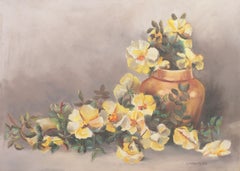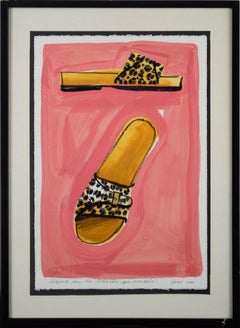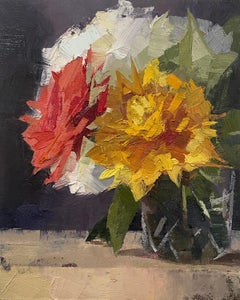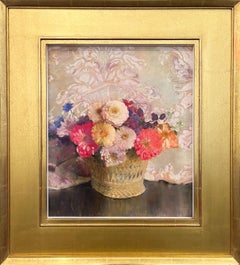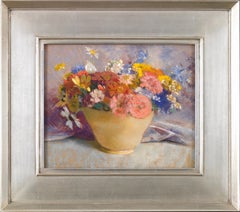Laura Coombs Hills Art
Born in Newburyport, Massachusetts, Laura Coombs Hills was the middle of five children born to Philip Knapp Hills, a town banker, and Mary Gerrish Hills. Little is known of Hills’s early childhood, other than that she received lessons from Emily Andrews, a local watercolorist. In the 1870s, Hills spent three winters in classes taught by Helen Knowlton, a devoted pupil of William Morris Hunt. Living in Boston in the late 19th century, a propitious moment in the local art scene, Hills was probably also influenced by the work of young painters such as Frank Benson, Edmund Tarbell and Willard Metcalf, particularly when she studied at the Cowles Art School.
By 1882, Hills was listed as a member of the Art Students League in New York. Hills’s biographer, Sandra Lepore, observed that, although “Hills attained a certain proficiency with oil paint in this period, she increasingly favored watercolor and pastel” (in "Laura Coombs Hills: A Retrospective," exhib. cat. [Newburyport, Massachusetts: Historical Society of Old Newbury, 1996], p. 14). Indeed, Hills’s first solo exhibition, at the gallery of J. Eastman Chase in Boston, consisted entirely of pastels. Soon, Hills established a routine of spending the winters in Boston at her studio on Chestnut Street and then returning to Newburyport for summers at “The Goldfish,” a house Hills designed and built in 1900 on the bank of the Merrimack River, which still stands today. Her companions were her sister Lizzie, who devoted her life to maintaining the household, and Karoline Burnhome, a close friend from Laura’s hometown.
Although Hills became known for her portrait miniatures in the first decades of the 20th century, around 1920 failing eyesight caused her to turn her focus once again to pastels. From then on, Hills made a niche for herself with bright, colorful pastels of flower arrangements. She was exacting in her choice of materials, using pastel crayons imported from Paris or Dresden to depict flowers cultivated by Lizzie in their garden.
Peonies, larkspur, lilies, tea roses and zinnias became favorites for Hills. They would be fresh cut in the morning, and then painstakingly arranged in a vase in front of a decorative backdrop. Sometimes, too, she added electric light, which, she said, “woke those lilies up and made them speak” (Lepore, op. cit., p. 21). Working quickly, she was nevertheless meticulous in the arrangement of her compositions, for there was “no place in art for slipshod careless work” (Lepore, op. cit., p. 19). Indeed, the present work remarkably demonstrates the passion, vigor, and skill that Hills brought to all her floral compositions.
With its vibrancy and saturated colors, Still Life with Flowers in an Earthenware Jug is typical of Hills’s finest still lifes. Proving her ability as a master colorist, the juxtaposition of highly contrasting purples and yellows results in a lively and unorthodox floral arrangement. When the owner of the Copley Gallery, Frank Bayley, proclaimed in 1951 that she broke all the rules of color, Hills responded: “I don’t know about the rules. I was experimenting. Use of color depends so much upon balance, shape and manipulation” (Lepore, op. cit., p. 21). Many of her backdrops, of which she was particularly proud, consisted of various scarves and fabrics she had collected on trips to Europe.
Hills achieved significant recognition during her lifetime. Her still lifes, portraits in pastel and elegant portrait miniatures in watercolor on ivory were exhibited to wide praise in Boston, New York, Paris, Buffalo, San Francisco and Philadelphia. She was awarded numerous medals, including a bronze medal at the Exposition Universelle, Paris, in 1900, silver medals at the Pan American Exposition, Buffalo, in 1901, and the Charleston Exposition, South Carolina, in 1902, and a gold medal at the Universal Exposition, St. Louis, in 1904. Hills also won medals of honor at the 1915 Panama-Pacific Exposition, San Francisco, and in the 1916 Annual Exhibition at the Pennsylvania Academy of the Fine Arts, Philadelphia.
(Biography provided by Hirschl & Adler)
1910s Naturalistic Laura Coombs Hills Art
Pastel, Postcard
20th Century American Impressionist Laura Coombs Hills Art
Pastel, Paper
Early 2000s American Impressionist Laura Coombs Hills Art
Paper, Crayon, Acrylic, Watercolor
2010s American Impressionist Laura Coombs Hills Art
Oil, Board, Paper
1980s Impressionist Laura Coombs Hills Art
Paper, Pastel, Watercolor
1930s American Impressionist Laura Coombs Hills Art
Paper, Watercolor
21st Century and Contemporary Naturalistic Laura Coombs Hills Art
Paper, Gesso, Watercolor, Gouache
21st Century and Contemporary Naturalistic Laura Coombs Hills Art
Paper, Gesso, Watercolor, Gouache
1940s American Impressionist Laura Coombs Hills Art
Paper, Pastel
1980s American Impressionist Laura Coombs Hills Art
Paper, Watercolor
1990s American Impressionist Laura Coombs Hills Art
Paper, Oil Pastel
2010s Contemporary Laura Coombs Hills Art
Enamel, Wire
1970s Impressionist Laura Coombs Hills Art
Paper, Pastel
1970s Impressionist Laura Coombs Hills Art
Paper, Pastel
Early 20th Century American Realist Laura Coombs Hills Art
Pastel, Fiberboard
1910s Impressionist Laura Coombs Hills Art
Paper, Pastel, Illustration Board
1910s Impressionist Laura Coombs Hills Art
Gouache, Pastel
